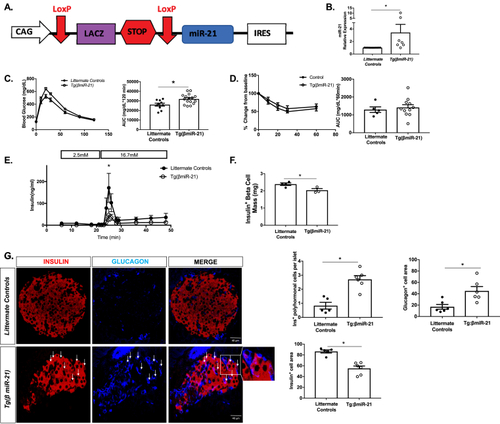Figure 6
- ID
- ZDB-FIG-210819-6
- Publication
- Ibrahim et al., 2021 - β-Cell pre-miR-21 Induces Dysfunction and Loss of Cellular Identity by Targeting Transforming Growth Factor Beta 2 (Tgfb2) and Smad Family Member 2 (Smad2) mRNAs
- Other Figures
- All Figure Page
- Back to All Figure Page
|
Tg(βmiR-21) mice are glucose intolerant and display a phenotype of islet β-cell dysfunction and loss of identity (A) Construct for Tg(βmiR-21) mice. For all experiments, tamoxifen-treated Tg(βmiR-21) mice were compared to tamoxifen-treated Tg(CAG-Z-miR-21-EGFP) mice and tamoxifen-treated Ins1tm1(CreERT2)Thor mice. (B) miR-21 levels are increased in islets from the Tg(βmiR-21) mice. (C) Glucose tolerance testing (GTT) showed that the Tg(βmiR-21) mice are glucose intolerant as compared to littermate controls. (D) Insulin tolerance testing (ITT) showed no differences between Tg(βmiR-21) mice and controls. (E)Ex vivo perifusion analysis showed a significant decrease in peak insulin secretion in islets from Tg(βmiR-21) mice. (F) Immunohistochemistry analysis demonstrated decreased insulin + β-cell mass in Tg(βmiR-21) mice. (G) Tg(βmiR-21) islets exhibited increased insulin+ glucagon+ co-expressing cells (white arrows). Tg(βmiR-21) islets also demonstrated an increase in glucagon+ cell area and a decrease in insulin+ cell area. n = 5–15 for metabolic testing islet RT-PCR and n = 3–4 mice for histologic analyses; ∗p < 0.05. |

